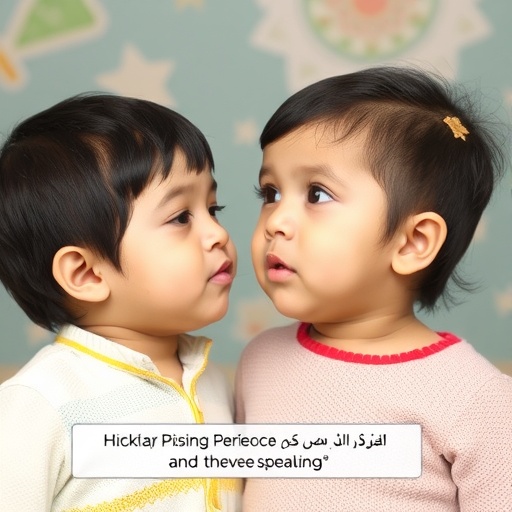
In a groundbreaking study set to redefine the landscape of speech recognition, a team of researchers has provided invaluable insights into the development of a specialized speech recognition test. The research, led by Nozari, Tajik, and Ahmadi, delves into how this innovative test can be utilized with typically-developing Persian-speaking children. The full scope of their findings has been detailed in their upcoming publication in BMC Pediatrics, and it promises to pave the way for future advancements in both clinical practice and technology.
The need for customized speech recognition tests has never been clearer. As technology continues to flourish, it becomes essential to develop tools that cater to specific linguistic and cultural contexts. The researchers recognized a significant gap in the existing literature regarding Persian-speaking populations, as most speech recognition technology has been predominantly developed for English and other widely spoken languages. This study not only addresses that gap but also shines a spotlight on the intricacies involved in designing and implementing reliable speech recognition assessments for children.
Central to this study was the methodology employed in developing the speech recognition test. The researchers adopted a systematic approach, ensuring that the test would be both reliable and valid for its intended population. They meticulously crafted a series of phonemes and linguistic tasks tailored specifically to the phonetic norms of the Persian language. This attention to detail is critical, as even subtle variations in phonetics can dramatically affect speech recognition outcomes.
The testing involved a diverse group of typically-developing Persian-speaking children from varying backgrounds, providing a rich dataset that enhances the reliability of the findings. The researchers implemented rigorous data collection techniques, monitoring how children interacted with the speech recognition technology and assessing their responses in real-time. This interactive element not only made the data collection process robust but also engaging for the participants, keeping them motivated throughout the assessments.
Moreover, the researchers explored the role of environmental factors, such as noise levels and the clarity of spoken language, on the children’s performance. They recognized that the effectiveness of speech recognition technology can be influenced by these external conditions, and thus, they designed the test to be adaptable to different environments. This adaptability is essential, particularly in real-world settings, where children might encounter varying degrees of background noise.
One of the standout findings from this research was the surprising level of accuracy achieved by the speech recognition test. The results indicated that with the appropriate adjustments and customizations for the Persian language, children’s speech could be recognized with unprecedented accuracy. This has profound implications for the future of language learning technologies, potentially enabling personalized learning experiences that are highly adaptive to the user’s linguistic abilities.
The technology employed in this study leverages advanced algorithms designed to recognize speech patterns and adapt to individual speakers over time. By utilizing machine learning techniques, the system can improve its performance as it encounters more data. This aspect of adaptability is crucial, particularly in the context of language acquisition, where the needs of children can vastly differ based on their unique linguistic backgrounds and experiences.
As the study continues to gain traction within academic circles, the potential applications extend beyond just education. For instance, the insights garnered could be integral in addressing various speech and language disorders. By understanding how typically-developing children interact with speech recognition technology, clinicians can craft more effective therapeutic interventions aimed at children who struggle with speech production or articulation.
Furthermore, this research advocates for the need for inclusive technologies that do not just cater to dominant languages but also embrace linguistic diversity. This shift is vital not only for equity in educational technology but also for fostering a more culturally rich environment where children can thrive. As technology becomes increasingly embedded in our everyday lives, it is critical that we ensure all children, regardless of their linguistic background, have equal access to these advancements.
In the face of rapid technological advancements, the demand for research and development in culturally relevant tools has escalated. The work of Nozari and colleagues serves as a critical reminder of the importance of tailoring scientific research to meet the needs of diverse populations. Their dedication to enhancing the speech recognition landscape for Persian-speaking children exemplifies how targeted research can lead to meaningful innovations in technology.
Looking ahead, there is a strong possibility that this research will catalyze further studies across other underrepresented language groups, sparking a movement toward more accessible speech recognition technologies globally. The implications of this work could inspire a new wave of interdisciplinary collaboration, bringing together linguists, educators, technologists, and healthcare professionals to develop even more nuanced solutions.
As the academic community and the tech industry prepare to engage with these findings, it is critical to focus on how we can leverage this knowledge to enhance educational outcomes. The detailed findings from the study will undoubtedly serve as a roadmap for future developments, fostering an environment where speech recognition technology can be seamlessly integrated into learning activities tailored for children.
The excitement surrounding this research is palpable, as it not only sheds light on an often-overlooked area within speech technology but also opens the door for future innovations. Anticipation builds for the official release of the research findings, which will undoubtedly be met with keen interest from educators, clinicians, and technology developers alike.
In conclusion, as we stand on the brink of a new era in speech technology, the work conducted by Nozari, Tajik, and Ahmadi highlights the profound impact that culturally aware and linguistically tailored research can have on the advancement of technology for children. Their pioneering efforts underscore a broader movement toward inclusivity in technological development that can foster genuine learning and support for children across diverse linguistic backgrounds.
Subject of Research: Development of a speech recognition test for typically-developing Persian-speaking children.
Article Title: Design and development of a speech recognition test: a study of typically-developing Persian-speaking children.
Article References:
Nozari, H., Tajik, S., Ahmadi, A. et al. Design and development of a speech recognition test: a study of typically-developing Persian-speaking children.
BMC Pediatr 25, 646 (2025). https://doi.org/10.1186/s12887-025-06058-w
Image Credits: AI Generated
DOI: 10.1186/s12887-025-06058-w
Keywords: speech recognition, Persian language, children, technology, education, inclusivity, linguistics, machine learning.
Tags: addressing gaps in speech recognition literaturecustomized speech recognition testsdeveloping reliable speech recognition toolsfuture advancements in speech recognitionimplications for clinical practice in speech therapyinnovations in speech technologylinguistic and cultural contexts in technologyNozari Tajik and Ahmadi researchpediatric speech recognition studiesspeech recognition assessment for Persian childrensystematic approach to speech assessment designtypically-developing children speech tests




